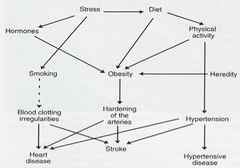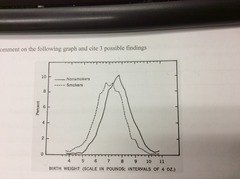Epidemiology – Quiz 2 – Flashcards
Unlock all answers in this set
Unlock answersquestion
Define : association:
answer
statistical dependence between 2 or more events, characteristics of other variables
question
Define/title of following image:

answer
web of causation
question
What is a graphic, or representation of complex sets of events or conditions caused by an array of activities connected to a common core or common experience or event:
answer
web of causation
question
What is something that increases the chances of getting a disease?
answer
risk factor
question
What is a behaviour that puts you at risk for a bad consequence?
answer
at risk behaviour
question
What is a conclusion about the presence of a health-related state or event and reason for its existence:
answer
causal inference
question
What are factors or conditions already present that produce a susceptibility or disposition in a host to a disease or condition without really causing it:
answer
predisposing factors
question
(T/F) No way to prove causal associations for most chronic disease and conditions
answer
True
question
(T/F) Causal inference is a simple process:
answer
False
question
Define Biologic gradient:
answer
evidence of dose-response relationship; an increased amount of exposure leads to increased risk of developing disease
question
Biologic gradient in relation to exposure is related to what?
answer
the evidence of a does-response relationship
question
What is the significance of Temporal Sequence?
answer
- exposure must precede disease - in diseases with latency periods, exposures must precede the latent period - in chronic diseases, often need long-term exposure for disease induction
question
Cite the difference between Positive reinforcing factors and Negative reinforcing factors:
answer
- Positive: support, enhance, and improve the control and prevention of the causation of the disease - Negative: factors that help aggravate and perpetuate disease, conditions, disability or death
question
Cite the difference between Direct and Indirect causal associations with an example for each:
answer
1. Direct causal association: no intermediate factor and is more obvious; eliminating the exposure will remove adverse health outcomes. (ex: exposure to staphy. pathogens result in illness) 2. Indirect causal association: involves 1 or more intevening factors; often much more complicated. (ex: high fat diet is associated with polyps, and polyps are associated with colon cancer)
question
Members of households of a person with TB don't uniformly acquire the disease from the index case. Cite 3 factors which could affect the occurrence of infection:
answer
- immune status - genetic susceptibility - exposure dose
question
Why is it important for us to be able to distinguish between an association due to a causal relationship and an association due to confounding (non-causal)?
answer
Answer: it makes a tremendous difference from both clinical and public health standpoints. If the relationship is causal: will succeed in reducing the risk of CHD if we lower cholesterol levels If relationship is due to confounding: then the increased risk of CHD is caused by factor X. Therefore, changes in the level of serum cholesterol will have no effect on the risk of CHD
question
Comment on the following graph and cite 3 possible findings (% of distribution by birth weight of infants of mothers who did not smoke during pregnancy vs. those that did)

answer
- entire weight distribution curve is shifte left in babies born to smokers - reduction in birth weight is not a result of shorter pregnancies - babies of smokers are smaller than those of non-smoker at each gestation age
question
Cite the types of causal associations:
answer
1. Direct causal associations: no intermediate factor and is more obvious ; eliminating the exposure will eliminate the adverse outcome 2. Indirect causal associations: involves 1 or more intervening factors ; often much more complicated; many risk factors
question
Cite the difference between necessary and sufficient causes:
answer
1. necessary = an exposure that is required for a certain outcome to happen ; is always associated with that outcome 2. sufficient = exposure that by itself will produce a particular outcome, but it may not be the only cause of outcome. So, the outcome may occur without the exposure if it is also caused by other exposures
question
Define: Necessary AND sufficient cause:
answer
a factor is both necessary and sufficient for producing the disease ex: lead exposure = lead poisoning
question
Define: necessary but not sufficient cause:
answer
each factor is necessary but not, in itself, sufficient to cause the disease; multiple factors are needed ex: alcoholism
question
Define: sufficient but not necessary causes:
answer
factor is not required to produce a specified outcome BUT when present, is able to cause the outcome by itself. Means that there are other causes of outcome ex: exposure X = outcome Y exposure Z ALSO = outcome Y
question
Define: neither sufficient nor necessary causes:
answer
a cause that isn't required to produce the outcome and when present is not able to cause the outcome by itself; hence there are other causes of the specified disease
question
How can we measure the strength of an association?
answer
- odds ratio - risk ratio
question
(T/F) epidemiology determines the cause of a disease in a given individual:
answer
False
question
(T/F) epidemiology determines the relationship or association between a given exposure and frequency of disease in populations
answer
True
question
Cite the difference between causal inference and statistical inference:
answer
1. Causal inference: provides scientific basis for medical and public health action; not a simple process; needs judgement and interpretation 2. Statistical inference: use of info from a sample to draw conclusions about the population from which sample was taken
question
John Stuart formed 3 methods of hypothesis formulation in disease etiology. What are they:
answer
- method of difference - method of agreement - method of concomitant variation
question
Define Temporality:
answer
exposure must precede disease
question
Importance of temporality with an example (asbestos and lung CA)
answer
- clarifying the order in which Exposure and disease occur - the length of the interval between the E and D ex: asbestos linked to increased risk of lung cancer BUT latent period between the exposure and appearance of lung can at least 20years
question
Define Biological gradient:
answer
dose-response relationship (increase amount of exposure with increase risk of disease)
question
Cite an example that shows the importance of coherence in difference epidemiologic patterns:
answer
presence of serological ____________ of Hep. B infection is associated with greatly increase rates of liver cancer. Those who have liver cancer have the genome for Hep. B
question
Define Specificity:
answer
an exposure is associated with only one disease, or the disease is associated with only one exposure
question
Match the following letters with numbers: a. attack rate b. person-time rate c. Berkson's bias d. healthy worker effect 1. incidence density 2. results in biases RR 3. results in underestimation of OR 4. cumulative incidence rate
answer
a = 4 b = 1 c = 3 d = 2
question
Which of the following is not a type of selection bias: a. health worker effect b. loss to follow-up c. Neyman bias d. all of the above are types of selection bias in cohort studies
answer
c - neyman bias
question
Which of the following is the most time consuming and costly study design? a. case control b. retrospective cohort c. prospective cohort d. cross-sectional
answer
c - prospective cohort
question
A valid statistical association in any analutical study design requires consideration of confounding. What is confounding?
answer
when an extrinsic factor influcences the disease outcome, and independent of that relationship, also influences the exposure affects both exposure and disease outcome
question
(T/F) Establishing a valid statistical association is a necessary part of establishing a cause-effect relationship
answer
True
question
(Chance/Bias/Confounding) A case-control study showed that a strong negative association existed between exercise and heart disease
answer
confounding
question
(Chance/Bias/Confounding) A case-control study found a positive association between self-reported alcohol use during pregnancy and fetal alcohol syndrome
answer
bias
question
(Chance/Bias/Confounding) A randomized clinical trial measured the association between found that drug A versus placebo did not significantly improve 10 year survival
answer
chance
question
(Chance/Bias/Confounding) A cohort study found no statistical association between smoking and coronary heart disease (RR=1)
answer
chance
question
(Chance/Bias/Confounding) The interviewer in a case-control study assumed that an association existed between alcohol consumption and MI. She was aware of whether individuals in the study had MI or not
answer
bias
question
Match the following (letter with numbers): a. blind b. increase sample size c. randomize 1. a way to control for confounding 2. a way to control for bias 3. a way to control for a chance finding
answer
a = 2 b = 3 c = 1
question
A precipitating factor is best defined as what?
answer
factors essential to the development of disease, conditions, injuries, disability and death
question
Match the following (letters with numbers) 1. method of difference 2. method of agreement 3. method of concomitant variation a. increased number of children not immunized against measles causes the incidence rate for measles to go up b. valley fever occurs only in the deserts of the southwestern US c. increasing trends in cigarette smoking is directly associated with increasing trends in lung CA in many diff. places in world
answer
1 = b 2 = c 3 = a
question
Which of the following is the best for establishing temporality? a. cross-sectional b. ecologic c- case-control d. experimental e. none of the above
answer
e. none of the above
question
Define random error:
answer
an error defined as the deviation of the total error from its average value (mean)
question
In contrast to systematic errors, the effect of the random errors may be reduced by ........... ?
answer
repitition of the experiment/observation and averaging the outcomes
question
_________________________________________________ is how close a number of measurements of the same quantity agree with each other, while ________________________________________________________ is how close the measurement is to the true value of the quantity being measured
answer
- the precision of measurement - the accuracy of measurement
question
_____________________________ - a random error appearing to cause an association between an exposure and an outcome
answer
chance
question
chance is caused by ____________________________ and it leads to _________________________
answer
- random error - unprecise results
question
The best way to avoid error due to random variation is ___________________________________________________________
answer
to increase the sample size
question
Avoiding bias at the design stage of a study is paramount because of the difficulty to ________________________________________________________________
answer
identify and account for it there after
question
CIte the types of bias:
answer
- selection bias - observational bias - confounding bias
question
A bias that results from selection of subjects into the sample or their allocation to treatment group producing a sample that is not representative of the population, or treatment groups that are systematically different
answer
selection bias
question
a phenomenon initially observed in studies of occupational diseases: workers usually exhibit lower overall death rates thatn the general populations because severly ill and chronically disabled are ordinarily exclded from employment
answer
healthy workers effect
question
a type of bias that results when cases and/or controls are recruited from hospital patients
answer
Berksonian bias
question
systematic differences in the way subjects remember or report exposures or outcomes
answer
recall bias
question
an interviewer's knowledge may influence the structure of questions and the manner of presentation which may influence responses
answer
interviewer bias
question
Define: loss to follow up:
answer
those that are lost to follow up, or who withdraw from the study may be different from thsoe who are followed for the entire study
question
Define: Hawthorne effect:
answer
an effect first documented at a Hawthorne manufacturing plant; people act differently when they know that they are being watched
question
Controls for confounding may be built into _____________________________ or ___________________________ of a study
answer
- the design - analysis stages
question
What are the aspects of design stage:
answer
- randomization (for experimental studies) - restriction (allow only those into the study who fit into narrow band of a potentially confounding variable) - matching (match cases and controls on the basis of the potential confounding variables - especially age and gender)
question
There are 2 kinds of analysis stage:
answer
1. Stratification: the process of grouping members of the population into relatively homogenous subgroups before sampling 2. Multivariate analysis: a generic term for any statistical technique used to analyze data from more than one variable
question
Cite 2 mechanisms that can produce selection bias:
answer
1. control selection bias 2. differential loss to follow up bias in a cohort study 3. self-selection bias - refusal to participate
question
Recall from participants can be faulty due to:
answer
a. systematic differences int he way subject remembers exposure and outcomes b. amplification of recollections - difficulty of tracking certain behaviours - reluctance to report embarassing moments



